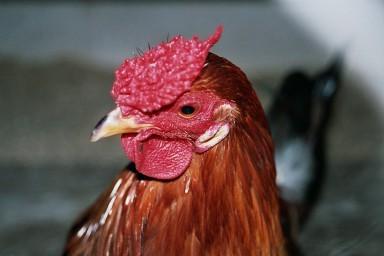Gallo pinto

Gallo pinto (or gallopinto) is the prototypical traditional dish of Nicaragua and Costa Rica cuisines. It is considered the national dish of both countries, although the two prepare it in a slightly different manner, and is eaten as a part of any meal. Though many variations exist, the dish at its most basic is composed of pre-cooked rice and beans fried together with spices such as cilantro, onion and peppers. It is often mixed with Salsa Lizano.
Name
The name gallo pinto means "painted rooster". When the beans and rice are combined, the rice gets colored by the beans, and the mix results in a multi-colored, or specked appearance. Nicaraguans traditionally prepare it with small red beans, while Costa Ricans usually use black beans. Beans are slowly cooked until the juice is almost consumed.
History
There is some controversy about whether the dish originated in Nicaragua or Costa Rica. Regardless of its origin, the dish is an integral part of both Costa Rican and Nicaraguan culture. A Costa Rican legend claims the name gallo pinto was coined around 1930 in San Sebastian, one of the southern neighborhoods of the capital, San José.
Nicaraguans hold to this day the world record on the biggest gallo pinto. The event, which has been done four years in a row every September 15th, broke its previous record of 18,400 served dishes. It took place and was organized by Pharaoh's Casino of Nicaragua. The new total of served dishes amounted to 22,200. All money went to El Pajarito Azul Home (charity).[1]
Variations
The dish has several variations including the addition of grated coconut which is primarily prepared on Costa Rica's Limón Province, Nicaragua's Caribbean coast, and surrounding areas. In some parts of Costa Rica many people serve gallo pinto with a fried egg on top.
There are other variations of this dish. One of them is known as Moros y Cristianos ("Moors and Christians") in Spain, but regarding the true nature of gallo pinto, it is believed that it came to be known through the Afro-Latino immigrants who live on the Caribbean coasts. They simply call it "rice and beans" and prepare it with coconut oil and/or shredded coconut. A similar dish is found in Panama, and in El Salvador where it is called casamiento. Other national variations include Dominican Republic and Puerto Rico (a variation with Gandul beans); Colombia (calentado paisa) and even Peru (tacu tacu)
References
- ^ Pineda, Edith (2006). "El gallo pinto más grande del mundo". El Nuevo Diario (in Spanish). Retrieved 2007-07-20.
{{cite news}}: Cite has empty unknown parameter:|coauthors=(help)
See also
- Cuisine of Costa Rica
- Cuisine of Nicaragua
- Hoppin' John - the equivalent dish in the Southern United States
- Pabellón criollo - the equivalent in Venezuela
- Platillo Moros y Cristianos - the Cuban equivalent

